Related Research Articles
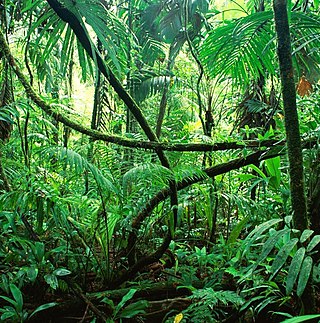
Rainforests are forests characterized by a closed and continuous tree canopy, moisture-dependent vegetation, the presence of epiphytes and lianas and the absence of wildfire. Rainforests can be generally classified as tropical rainforests or temperate rainforests, but other types have been described.

An epiphyte is a plant or plant-like organism that grows on the surface of another plant and derives its moisture and nutrients from the air, rain, water or from debris accumulating around it. The plants on which epiphytes grow are called phorophytes. Epiphytes take part in nutrient cycles and add to both the diversity and biomass of the ecosystem in which they occur, like any other organism. They are an important source of food for many species. Typically, the older parts of a plant will have more epiphytes growing on them. Epiphytes differ from parasites in that they grow on other plants for physical support and do not necessarily affect the host negatively. An organism that grows on another organism that is not a plant may be called an epibiont. Epiphytes are usually found in the temperate zone or in the tropics. Epiphyte species make good houseplants due to their minimal water and soil requirements. Epiphytes provide a rich and diverse habitat for other organisms including animals, fungi, bacteria, and myxomycetes.
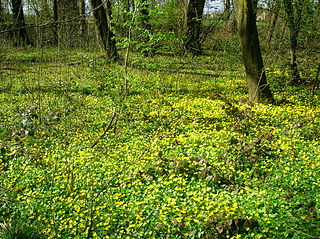
In forestry and ecology, understory, or understorey, also known as underbrush or undergrowth, includes plant life growing beneath the forest canopy without penetrating it to any great extent, but above the forest floor. Only a small percentage of light penetrates the canopy so understory vegetation is generally shade-tolerant. The understory typically consists of trees stunted through lack of light, other small trees with low light requirements, saplings, shrubs, vines and undergrowth. Small trees such as holly and dogwood are understory specialists.
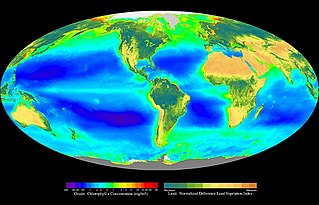
In ecology, primary production is the synthesis of organic compounds from atmospheric or aqueous carbon dioxide. It principally occurs through the process of photosynthesis, which uses light as its source of energy, but it also occurs through chemosynthesis, which uses the oxidation or reduction of inorganic chemical compounds as its source of energy. Almost all life on Earth relies directly or indirectly on primary production. The organisms responsible for primary production are known as primary producers or autotrophs, and form the base of the food chain. In terrestrial ecoregions, these are mainly plants, while in aquatic ecoregions algae predominate in this role. Ecologists distinguish primary production as either net or gross, the former accounting for losses to processes such as cellular respiration, the latter not.
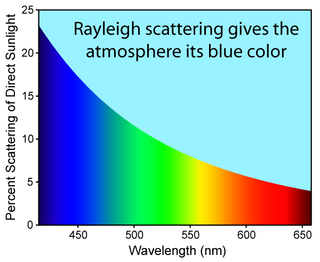
Diffuse sky radiation is solar radiation reaching the Earth's surface after having been scattered from the direct solar beam by molecules or particulates in the atmosphere. It is also called sky radiation, the determinative process for changing the colors of the sky. Approximately 23% of direct incident radiation of total sunlight is removed from the direct solar beam by scattering into the atmosphere; of this amount about two-thirds ultimately reaches the earth as photon diffused skylight radiation.

Tropical rainforests are rainforests that occur in areas of tropical rainforest climate in which there is no dry season – all months have an average precipitation of at least 60 mm – and may also be referred to as lowland equatorial evergreen rainforest. True rainforests are typically found between 10 degrees north and south of the equator ; they are a sub-set of the tropical forest biome that occurs roughly within the 28-degree latitudes. Within the World Wildlife Fund's biome classification, tropical rainforests are a type of tropical moist broadleaf forest that also includes the more extensive seasonal tropical forests.

An old-growth forest, sometimes synonymous with primary forest, virgin forest, late seral forest, primeval forest, first-growth forest, or mature forest—is a forest that has attained great age without significant disturbance, and thereby exhibits unique ecological features, and might be classified as a climax community. The Food and Agriculture Organization of the United Nations defines primary forests as naturally regenerated forests of native tree species where there are no clearly visible indications of human activity and the ecological processes are not significantly disturbed. More than one-third of the world's forests are primary forests. Old-growth features include diverse tree-related structures that provide diverse wildlife habitat that increases the biodiversity of the forested ecosystem. Virgin or first-growth forests are old-growth forests that have never been logged. The concept of diverse tree structure includes multi-layered canopies and canopy gaps, greatly varying tree heights and diameters, and diverse tree species and classes and sizes of woody debris.
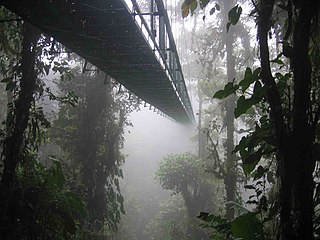
Canopy walkways – also called canopy walks, treetop walks or treetop walkways – provide pedestrian access to a forest canopy. Early walkways consisted of bridges between trees in the canopy of a forest; mostly linked up with platforms inside or around the trees. They were originally intended as access to the upper regions of ancient forests for scientists conducting canopy research. Eventually, because they provided only limited, one-dimensional access to the trees, they were abandoned for canopy cranes. Today they serve as ecotourism attractions in places such as Dhlinza Forest, KwaZulu-Natal, South Africa, Taman Negara National Park, Malaysia, Sedim River, Kulim, Nyungwe National Park, Rwanda and Kakum National Park, Ghana.
This article is the index of forestry topics.

In biology, the canopy is the aboveground portion of a plant cropping or crop, formed by the collection of individual plant crowns. In forest ecology, canopy refers to the upper layer or habitat zone, formed by mature tree crowns and including other biological organisms. The communities that inhabit the canopy layer are thought to be involved in maintaining forest diversity, resilience, and functioning. Shade trees normally have a dense canopy that blocks light from lower growing plants.

A treefall gap is a distinguishable hole in the canopy of a forest with vertical sides extending through all levels down to an average height of 2 m (6.6 ft) above ground. These holes occur as result of a fallen tree or large limb. The ecologist who developed this definition used two meters because he believed that "a regrowth height of 2 m was sufficient" for a gap to be considered closed, but not all scientists agree. For example, Runkle believed that regrowth should be 10–20 m (33–66 ft) above the ground. Alternatively, a treefall gap is "the smallest gap [that must] be readily distinguishable amid the complexity of forest structure."

Margaret D. Lowman, Ph.D. a.k.a. Canopy Meg is an American biologist, educator, ecologist, writer, explorer, and public speaker. Her expertise involves canopy ecology, canopy plant-insect relationships, and constructing canopy walkways.

LI-COR Biosciences is an international biotech company which designs, manufactures, and markets instruments, measurement systems, and software for biological and environmental research, and develops relevant measurement methodologies and techniques.

Hemispherical photography, also known as canopy photography, is a technique to estimate solar radiation and characterize plant canopy geometry using photographs taken looking upward through an extreme wide-angle lens or a fisheye lens. Typically, the viewing angle approaches or equals 180-degrees, such that all sky directions are simultaneously visible. The resulting photographs record the geometry of visible sky, or conversely the geometry of sky obstruction by plant canopies or other near-ground features. This geometry can be measured precisely and used to calculate solar radiation transmitted through plant canopies, as well as to estimate aspects of canopy structure such as leaf area index. Detailed treatments of field and analytical methodology have been provided by Paul Rich and Robert Pearcy (1989).

The crown of a plant refers to the total of an individual plant's aboveground parts, including stems, leaves, and reproductive structures. A plant community canopy consists of one or more plant crowns growing in a given area.

Myxogastria/Myxogastrea or Myxomycetes (ICN), is a class of slime molds that contains 5 orders, 14 families, 62 genera, and 888 species. They are colloquially known as the plasmodial or acellular slime moulds.
Cretaceous polar forests were temperate forests that grew at polar latitudes during the final period of the Mesozoic Era, known as the Cretaceous Period 145–66 Ma. During this period, global average temperature was about 10 °C (18 °F) higher and carbon dioxide (CO2) levels were approximately 1000 parts per million (ppm), 2.5 times the current concentration in Earth's atmosphere. The abundance of atmospheric carbon dioxide had a very significant impact on global climate and Earth's natural systems as its concentration is considered one of the main factors in the development of a pronounced greenhouse Earth during the Cretaceous, with a very low average global temperature gradient. As a consequence, high paleolatitudes in both hemispheres were much warmer than at present. This temperature gradient was partly responsible for the lack of continental ice sheets in polar regions.
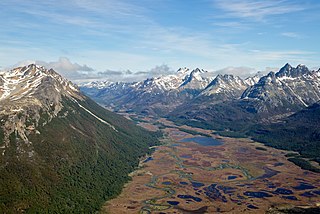
A mire, peatland, or quagmire is a wetland area dominated by living peat-forming plants. Mires arise because of incomplete decomposition of organic matter, usually litter from vegetation, due to water-logging and subsequent anoxia. All types of mires share the common characteristic of being saturated with water, at least seasonally with actively forming peat, while having their own ecosystem. Like coral reefs, mires are unusual landforms that derive mostly from biological rather than physical processes, and can take on characteristic shapes and surface patterning.

Paul Gordon Jarvis was a leading ecologist and Professor of Forestry and Natural Resources at the University of Edinburgh from 1975 to 2001.
Ernesto A. Medina is a plant ecologist specializing in plant physiology when adapting to the changing environment. He is an elected international member of the National Academy of Sciences, and is adjunct professor in the department of Center for Applied Tropical Ecology and Conservation (CREST-CATEC).